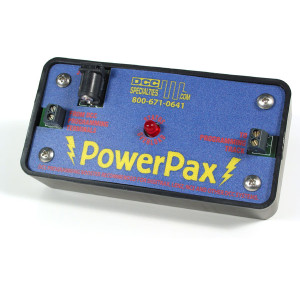Why Program Track Boosters are Needed
Contributed by Mark Gurries and the NCE Yahoo! Group
What can you expect a PTB100 and Power Pax Programming Track Booster to do when connected to the programming track of a DCC system other than just writing a CV setting?
You will be able to RESTORE THE LOST CV READ capability of the programming track when working with sound decoders. Simplistically, this is the primary purpose of the programming track booster.
A fully compliant NMRA DCC programming track is an electrically "safe place" to test locomotives without blowing up decoders. It is intentionally designed to provide a very small amount of current to the track. If there is a short on the locomotive, the short will NOT cause any damage to any electronics. Decoder's know this environment and shutdown everything but remain alive enough to communicate. There is not even enough current to run the motor. The original NMRA DCC specifications/standard for the Programming Track was written/developed BEFORE the existence of sound decoders. Eventually sound decoders were introduced and they presented a unique transient current load condition on the programming track that the programming track was never intended to support. It took a long while, but the NMRA finally updated the DCC Programming track specification/standard to address a sound decoder's power needs while still keeping the programming track safe.
With respect to multiple DCC manufactures and the adoption of the updated programming track standard:
1) NEW DCC systems, There have only been been a few that have been updated to follow the NEW NMRA programming track specification. NCE’s PowerCab falls into this category.
2) OLD DCC systems: Many in production today still follow the ORIGINAL OLD NMRA programming track specification. They have not been updated. NCE’s PowerPro falls into this category.
There are two problems. Writing and Reading on the Programming Track which are both directly tied to the power problem..
The Programming Track booster is sort of like a Booster for running trains but is specifically designed to maintain the electrically "safe place" programming track environment. A programming track booster adds additional TRANSIENT current capability support and still allows reading and writing CV values.
Programming Track boosters do not limit the number nor the type of CV’s you can access in any way. They are transparent devices to the programming track interface of the DCC system.
For more information, go here:
https://sites.google.com/site/
https://sites.google.com/site/

